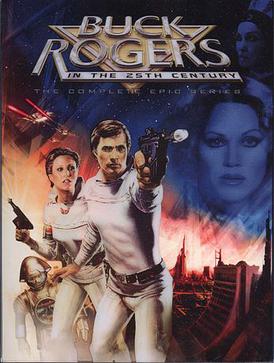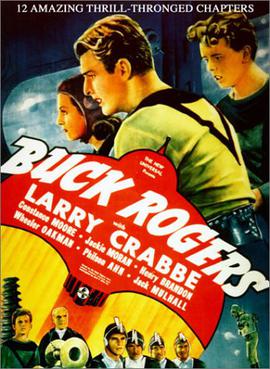Battlestar Galactica is an American science fiction media franchise created by Glen A. Larson. It began with the original television series in 1978, and was followed by a short-run sequel series, Galactica 1980, a line of book adaptations, original novels, comic books, a board game, and video games. A reimagined version aired as a two-part, three-hour miniseries developed by Ronald D. Moore and David Eick in 2003, followed by a 2004 television series, which aired until 2009. A prequel series, Caprica, aired in 2010.

Glen Albert Larson was an American television producer, writer, musician, and director. His best known work in television was as the creator of the television series Alias Smith and Jones, Battlestar Galactica, Buck Rogers in the 25th Century, The Misadventures of Sheriff Lobo, Quincy, M.E., The Hardy Boys/Nancy Drew Mysteries, B. J. and the Bear, The Fall Guy, Magnum, P.I. and Knight Rider. In addition to his television work, Larson also was a member of the folk revival/satire group The Four Preps.

Gil Gerard is an American actor, whose roles include Captain William "Buck" Rogers in the 1979–81 television series Buck Rogers in the 25th Century.

Pamela Hensley is an American actress and author. Her notable acting roles include Princess Ardala on the 1979–1981 television series Buck Rogers in the 25th Century and C.J. Parsons on the 1982–1985 television series Matt Houston. She also appeared in Rollerball and Doc Savage and Double Exposure (1982).
Draconian is an adjective meaning "of great severity", that derives from Draco, an Athenian law scribe under whom small offenses had heavy punishments.

Flash Gordon Conquers the Universe is a 1940 American black-and-white science-fiction 12-chapter movie serial from Universal Pictures, produced by Henry MacRae and co-directed by Ford Beebe and Ray Taylor. The serial stars Buster Crabbe, Carol Hughes, Charles B. Middleton, Frank Shannon, and Roland Drew. It was written by George H. Plympton, Basil Dickey, and Barry Shipman, and was adapted from Alex Raymond's syndicated newspaper comic strip of the same name from King Features Syndicate. Shown theatrically in 12 separate weekly "chapters", it was the last of the three Universal Flash Gordon serials made between 1936 and 1940.
Wilma Deering is a fictional character featured in the various iterations of Buck Rogers which have spanned many media over the years.

Juanin Clay was an American actress whose films included WarGames and The Legend of the Lone Ranger.
Eric Server is an American television actor, best known for providing the voice of computer brain Dr. Theopolis in the 1979 TV series Buck Rogers in the 25th Century. From 1979 to 1981 he appeared as Lt. Jim Steiger in 17 episodes of B.J. and the Bear.

Buck Rogers in the 25th Century is an American science fiction adventure television series produced by Universal Studios. The series ran for two seasons between September 1979 and April 1981 on NBC, and the feature-length pilot episode for the series was released as a theatrical film before the series aired. The film and series were developed by Glen A. Larson and Leslie Stevens, based on the character Buck Rogers created in 1928 by Philip Francis Nowlan that had previously been featured in comic strips, novellas, a serial film, and on television and radio.

Felix Anthony Silla, also credited as Felix Cilla, was an Italian character actor, circus performer, voice artist and movie stuntman, best known for his career in Hollywood in TV and film.

"Saga of a Star World" is the pilot for the American science fiction television series Battlestar Galactica which was produced in 1978 by Glen A. Larson. A re-edit of the episode was released theatrically as Battlestar Galactica in Canada before the television series aired in the United States, in order to help recoup its high production costs. Later, the standalone film edit was also released in the United States.

Buck Rogers: A Life in the Future is the title of a science fiction novel by Martin Caidin published in 1995.

Buck Rogers is a 1939 science fiction film serial, produced by Universal Pictures. It stars Buster Crabbe as the eponymous hero, Constance Moore, Jackie Moran and Anthony Warde. It is based on the Buck Rogers character created by Philip Francis Nowlan, who had appeared in magazines and comic strips since 1928.
Killer Kane is a fictional character in the Buck Rogers comic strip and its subsequent 1939 Buck Rogers serial film produced by Universal Studios. The character also appeared in the 1979 film and subsequent TV series, in which he was a defector from Earth to the Draconian Empire and sought to assist its malevolent leader Emperor Draco and his daughter Princess Ardala in their plans to conquer Earth.

Erin Gray is an American model, casting agent, and actress whose roles include Colonel Wilma Deering in the science fiction television series Buck Rogers in the 25th Century and Kate Summers-Stratton in the situation comedy Silver Spoons.
Buck Rogers is a science fiction adventure hero and feature comic strip created by Philip Francis Nowlan first appearing in daily U.S. newspapers on January 7, 1929, and subsequently appearing in Sunday newspapers, international newspapers, books and multiple media with adaptations including radio in 1932, a serial film, a television series, and other formats.
Suspended animation in fiction refers to the temporary cessation of life processes experienced by fictional characters, followed by their subsequent revival. This process is commonly employed as a plot device in science fiction narratives. It is frequently utilized to transport a character from the past to the future or to facilitate interstellar space travel, which necessitates an extended journey for months or years. In addition to accomplishing the character's primary objective in the future, they often encounter the unfamiliarity of a new world, which may bear only faint resemblance to their previous surroundings. On occasion, a character is portrayed as possessing skills or abilities that have become lost to society during their period of suspension, enabling them to assume a heroic role in their new temporal setting.
Buck Rogers in the 25th Century was a radio drama series based on the popular novel and comics series Buck Rogers. It aired from 1932-1936, 1939, 1940 and 1946-1947, and it was notable for being the first science fiction radio show.











